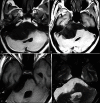Intracranial epidermoid tumor; microneurosurgical management: An experience of 23 cases
- PMID: 23741259
- PMCID: PMC3667457
- DOI: 10.4103/1793-5482.110276
Intracranial epidermoid tumor; microneurosurgical management: An experience of 23 cases
Abstract
Objectives: An intracranial epidermoid tumor is relatively a rare tumor, accounting for approximately 0.1% of all intracranial space occupying lesions. These are also known as pearly tumor due to their pearl like appearance. In this series, the localization of the tumor, presenting age and symptoms, imaging criteria for diagnosis, surgical management strategy with completeness of excision and overall outcome were studied prospectively. Here, we report our short experience of intracranial epidermoid as a whole.
Materials and methods: Between January 2006 to December 2010, 23 cases of intracranial epidermoid were diagnosed preoperatively with almost certainty by computed tomography (CT) and magnetic resonance imaging (MRI) of brain in plain, contrast and other relevant studies. All of them underwent operation in Dhaka Medical College Hospital and in some Private Hospital in Dhaka, Bangladesh. All patients were followed-up routinely by clinical examination and neuroimaging. Average follow-up was 39 (range-71-11months) months. Patients of the series were prospectively studied.
Results: Supratentorial epidermoids were 04 cases and infratemporal epidermoids were 19 cases. Clinical features and surgical strategy varies according to the location and extension of the tumors. Age range was 19-71 years (37.46 years). Common clinical features were headache, cerebellar features, seizure, vertigo, hearing impairment and features of raised intracranial pressure (ICP). Investigation was CT scan or/+ MRI of brain in all cases. Pre-operative complete excision was 20 cases, but post-operative images showed complete excision in 17 cases. Content of tumor was pearly white/white material in all cases except one, where content was putty material. Re-operation for residual/recurrent tumor was nil. Complications included pre-operative mortality one case, persisted sixth nerve palsy in one case, transient memory disturbance one case, and extra dural hematoma one case. One senior patient expired three months after the operation from spontaneous intracerebral hemorrhage. Rest of the patients were stable and symptom/s free till last follow-up.
Conclusion: In the management of such tumors, one should keep in mind that an aggressive radical surgery carrying a high morbidity and mortality and a conservative subtotal tumor excision is associated with a higher rate of recurrence, but earlier diagnosis and complete excision or near total excision of this benign tumor can cure the patient with the expectation of normal life.
Keywords: Epidermoid tumor; intracranial; neurosurgical management.
Conflict of interest statement
Figures






References
-
- Bauman CH, Bucy PC. Paratrigeminal epidermoid tumors. J Neurosurg. 1956;13:455–68. - PubMed
-
- Fleming JF, Botterell EH. Cranial dermoid and epidermoid tumors. Surg Gynecol Obstet. 1959;109:403–11. - PubMed
-
- Abramson RC, Morawetz RB, Schli HM. Multiple complications from an intracranial epidermoid cyst: Case report and literature review. Neurosurg. 1989;24:574–8. - PubMed
-
- Alvord EC., Jr Growth rates of epidermoid tumors. Ann Neurol. 1997;2:367–70. - PubMed
-
- Bartal A, Razon N, Avram J, Rockkind S, Doron A. Infratentorial epidermoids. Acta Neurochir (Wien) 1988;42:142–6. - PubMed
LinkOut - more resources
Full Text Sources
Other Literature Sources

